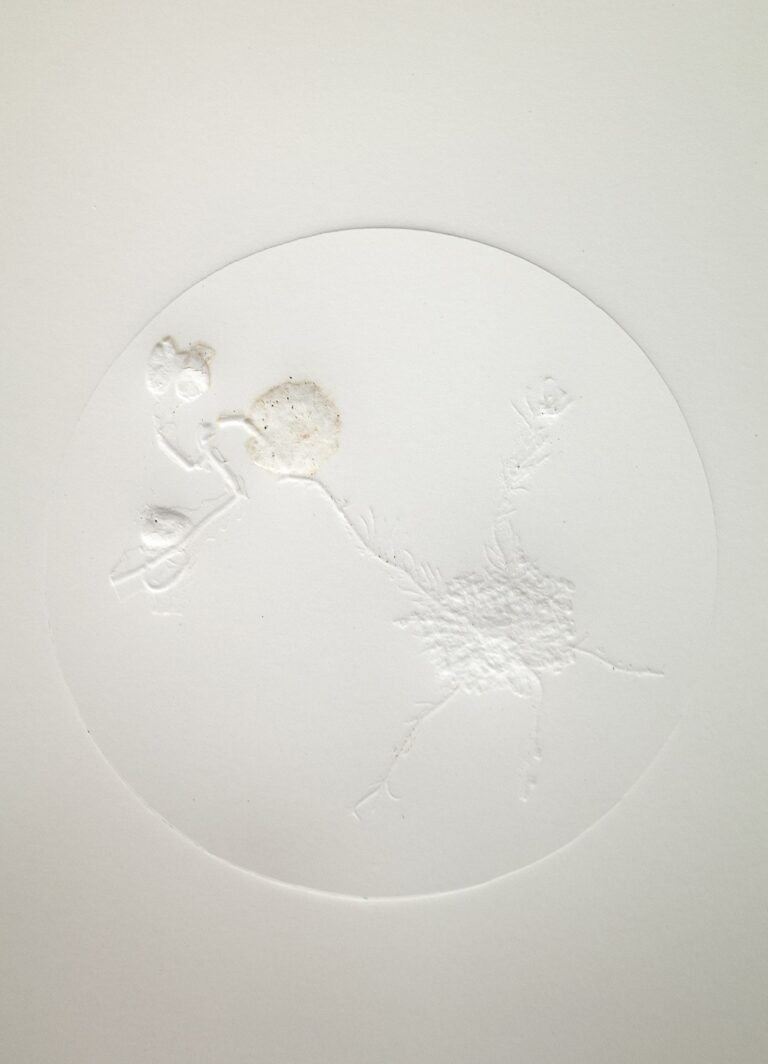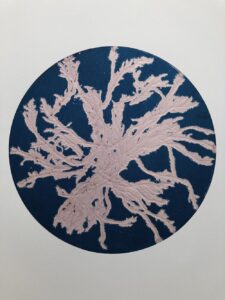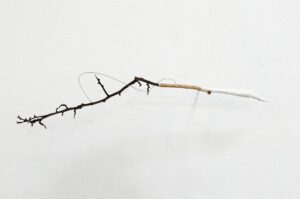(is)land

ma degree exhibition
dia thomas
aster reem david
brandon lomax
august 18-september 9 | 2022
opening reception | thursday | august 18 | 6-8pm
opening remarks by maeve stone
burren college of art | ballyvaughan | H91 DX2N
gallery hours | mon-fri | 9:30am-5:00pm
contact@burrencollege.ie | +353 65 7077200
(is)land
(is)land is a collaboration among three multidisciplinary artists, examining themes of transcendence and transfiguration through artistic expression. Employing ideas of compassion across a spectrum of ecologies, the collective works explore the human experience within an environment.
Installed as individual parts of a greater whole, (is)land reimagines the traditional gallery space as an archipelago of sorts—a deteriorating bridge between the mainland and satellite land masses, between the mainstream and the individual. The installed works function much like an ecosystem, with each part contributing to a collective whole. Cultural, biological, phenomenological, or otherwise, the exhibition highlights the interconnective tissue between humans, non-humans, and everything.
Each artists’ distinct interpretations take viewers on a journey to reimagine the cosmos from the subatomic to the infinite. The works reference the higher self as an integral player in the survival of our species, magnifying and distorting scale in order to consider multiple perspectives in one experience. The result is a shared intellectual ecosystem of inclusion, empathy, and awareness to which all are welcome.
The works on view span a broad range of interdisciplinary practices, including digital media, film, sculpture, photography, print, performance, and installation.
dia thomas
Dia Mariam Thomas is a multidisciplinary artist from India, currently pursuing her masters in Studio arts at the Burren college of Arts, Ballyvaughan, Ireland. Her work focuses on the human experience, the challenges and trials of being a women. At the core, her work aims to dismantle archaic laws and silencing cultures, drawing on her experiences and stories from India. Dia’s ode to women, set against patriarchal and colonial backdrops urges one into deep thought about how cultural systems, histories, attitudes and laws suppress and trivialise women.
The central themes of my piece revolve around the deeply enriched entrenched history of colonialism in India and the remnants of this past that have become part of our culture. At the core of my work is the patriarchal power that overarches Indian society and its sociocultural systems. These two elements circle around each other and are presented to the viewer through a multidisciplinary installation.
Through these pieces, I aim to capture the deep sorrow borne in the struggles every generation of women (in India) face because of patriarchal power and a language of violence towards women. The works mirror each other, showing that no caste, religion or creed can protect women unless a power shift is enacted, and the patriarchal system is diluted.
In the performance piece, the survivor washes her wounds and the horrors away using water that has her grandmother’s picture at the bottom. The various elements of my work showcase how these horrors continue, unchanged, silenced and forgotten; how this is the absolute power of the patriarchy.
The colonial elements are subtler – the traditional Indian wear of the Saree is altered to omit the blouse that was introduced during colonial rule. This is an absolute act of defiance, a slice of power that this piece grants to the survivor.
The white tones, water and the natural elements used invoke a sense of fluidity which juxtaposes against the central running themes of colonialism, sexual violence, and the patriarchy. This carefully creates an atmosphere of discomfort – settled within peace, a generational story of abuse and mistreatment unfolds. It forces the audience to confront its own beliefs and ideas, and engage in a dialogue.
Performance for me, almost becomes an act of feminism creating a series of discomfort, shame and resentment among the viewers and making the artist both vulnerable and empowered.
I seek to explore the relation of my body as both process and subject/object, as an experience and main highlight in the creative act, as a living matter related to space, time and viewer. The body that displays the artist’s thought and the body as the heart of a phenomenological issue.

aster reem david
Aster Reem David (b. 1988, Pakistan) is a multidisciplinary artist working with photography, printmaking, installation, and mixed media. Her research centres on the themes of landscape and ecology emphasising human and more-than-human relationships. Aster’s studio practice is rooted in layers of experimental processes that reflect and collaborate with the natural world. She received her BA in Photographic Arts from the University of Westminster, London. Aster is currently based in west Ireland studying a master’s programme in Art & Ecology with a research and studio focus on Queer Ecology.
Queer Mesh and the Strange Stranger is an ongoing research project that considers the complexity of human and non-human interrelations through the queer lens. Guided by the theoretical framework of queer ecology and ecological thought, this year-long project was born out of a desire to examine and deconstruct the confines of binary thinking, human exceptionalism and the anthropocentric perspective in which Nature and the non-human world are represented; to imagine an entangled web of all beings, living and non-living that constitutes a mesh.
The mesh suggests vastness beyond comprehension. All life forms in a mesh coexist and interact with each other. It is a complex queer cobbling of multispecies relationships. It doesn’t fit inside a box. The mesh also implies an intimacy of everything and everyone, entangled in a messy and fragile web that constitutes strange strangers. The notion of ‘strange stranger’ refers to non-human critters, imagined as ambiguous beings that resist binary categorisation. If the mesh was imagined through the intimacy of the strangest beings which go beyond human comprehension, then perhaps it can be argued that all sorts of seeming impossibilities are possible including the queerness of the mesh. The profundity of this framework then generates scope for multiple interpretations of the mesh.
I propose a mesh that is teeming with possibilities – a mesh that is intrinsically queer by considering the interdependency and inclusivity of humans, non-humans, and all things in-between. It is all-encompassing. In this mesh, the familiar becomes strange and the strange familiar. The queer mesh has no starting or end point. To experience it, intimacy and fluidity are encouraged. It also draws attention to the overlooked, peripheral beings like moss and lichen. They amalgamate with other beings and form clusters of ecosystems that are intertwined, yet coexist and interact with one another, on a scale that is both infinite and infinitesimal. In a way, mimicking the symbiotic relationship that lichen forges with fungi and algae.
Queer Mesh and the Strange Stranger is an expanded installation of animate and inanimate materials, found objects, and scientific equipment. The works are informed by hybrid methodologies of printmaking and alternative photographic processes used outside of their conventional etiquettes; in a way queering them. Layers of experimentation of processes on paper form new hybrid species that are uncanny. They are not gendered. They defy scientific categorisation. They are intrinsically queer in their form and creation. They are the strange strangers within the queer mesh. The appropriation of scientific methods and playful displays are used as tools of subversion to challenge the anthropocentric lens through which nature and the more-than-human world are seen.
This work invites the viewer to consider: who, or what, is interconnected with what, or with whom?

brandon lomax
Brandon Lomax is a sculptor and installation artist whose immersive experiences transport viewers through time and space, and back into themselves. His work is process-driven, informed by ecology and artifact and rooted in anthropological study.
Lomax’s site-specific public exhibitions punctuate time by encapsulating history into the rhythm of natural, daily cycles. He engages with ideas of logic, inequality and empathy, and strives to remind participants of their place within the cosmos and beyond.
Lomax has exhibited with galleries, art fairs and Institutions in the US and internationally. His work is held in numerous private and institutional collections, including The Bunker in West Palm Beach, FL and the California Botanic Garden in Claremont, CA. He currently resides on the West Coast of Ireland, where he is studying the formations, flora and fauna of the glaciated karst landscape of the Burren.
In recent studio research, I have been focusing on unexpected material pairings, multispecies collaboration, and intervention as a means to create tension and provoke engagement. In many of my studio investigations, I have been partnering (hu)manufactured materials with naturally-occurring and found detritus. In highlighting the interconnective tissue that exists among all things, I employ an anthropocentric perspective as a tool to access human empathy and understanding in the viewer.
My practice exists in the hypothetical, dancing with two left feet between spirituality and quantum physics. I attempt to employ the complex ideas of multi-dimensionality and transcendence to explore the realms of human emotion and its connection to all that exists in the more-than-human world. Relying on context to moderate and equalize individual experience, my work is an ongoing personal research project with the overall goal of providing a visual and sometimes sonic interpretation to the complex and abstract phenomena that unite our entire universe. I am seeking to both memorialize and embrace the ephemerality of life as we understand it and beyond.
Utilizing a minimal aesthetic and a personal perspective, I am striving to provide form and function to that which is considered unknowable or perhaps just beyond human understanding. Fundamentally, this, and all of my work, is about perception. It is consistently informed by place, emotion, experience, and time. I attempt to consider all life and perspective equally. Sentient and otherwise, human and more-than-human. After all, we are all in this together.

